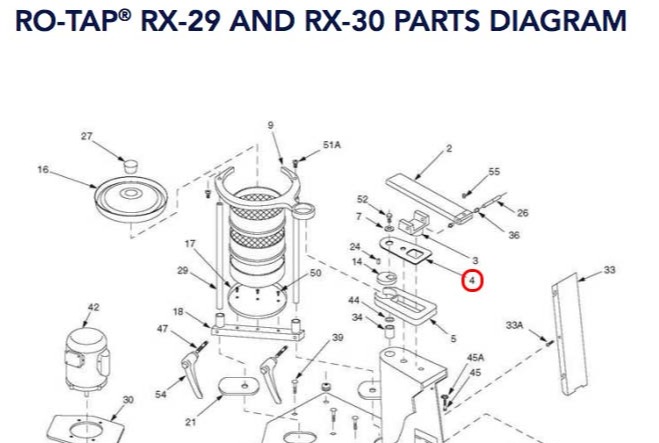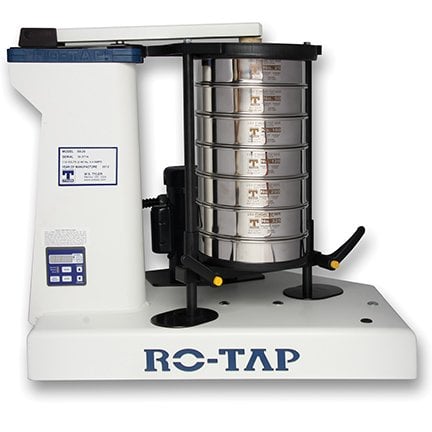5 Reasons Your Sieve Shaker is Noisy (With Solutions)
"How do I know if my sieve shaker is too loud?"
"Is my Ro-Tap broken??
"I think my sieve shaker is making a strange noise..."
If you use a sieve shaker and have had one of these questions before, you aren’t alone. We get asked questions like this all the time.
A sieve shaker is a complex machine, and sometimes it needs to be repaired or requires maintenance, but sometimes it’s just making its normal level of noise.
Most of the time, the issue of noise can be fixed by you and without a ton of work. This means you don’t suffer a great amount of downtime, but it does require you have some level of knowledge about your machine.
We wrote this list of the most common noise-related problems to help you troubleshoot your sieve shaker. There are a lot more reasons than five that your machine could be extra noisy, but these are the most common ones we encounter.
Why is your Ro-Tap so loud?
 Let’s get one thing out in the open: the Ro-Tap® Sieve Shaker is loud - and it should be.
Let’s get one thing out in the open: the Ro-Tap® Sieve Shaker is loud - and it should be.
The machine uses a hammer to tap particles down through a stack of test sieves while it oscillates and shakes. This tapping motion creates quite a bit of noise. If you have your unit in a sound enclosure cabinet, it could be a little quieter. But the machine runs at a volume of around 85 dB.
It’s normal for your machine to be loud. However, it is important that you know when your machine is making other noises (above the norm). This can sometimes indicate something else is wrong with your machine.
There are many other reasons that your machine could be making different sounds, but here are 5 of the most common explanations:
1. The Material you are Sieving is Heavy
The Ro-Tap is designed to work with all kinds of particle sizes from 4” opening down to 20 microns. The type of material you are using inside your machine could be making the machine louder than what you expected.
If you are sieving hard or large particles, like rocks or minerals, your machine might be a lot louder when it’s running.
On the other hand, if you are sieving fine particles, like flour or powders, the noise level may not increase at all.
These should be pretty straightforward noises to identify while your machine is running and is not something for any concern. It is just good to cover this first when talking about noise levels.
2. Your Machine is Not Secured.
This one may seem like a no-brainer, but we see this one coming up a lot when we talk to customers. The Ro-Tap is designed to be bolted down to a surface. This could be a table, the floor, a stand or a workbench.
When the machine is not bolted down, it can cause a lot of extra movement and possibly noise. Your machine may literally work itself off the edge of the table.
This will not only impact the level of noise the machine produces, but the performance of the machine as well. So, if you are hearing lots of excess noise and your machine isn’t secured - try securing it down and see if this eliminates some of the noise.
3. Parts on your Machine Needs to be Oiled.
The Ro-Tap is made up of lots of working parts and components, over 60 actually.
If you are hearing some grinding noises and you can tell which part of the Ro-Tap they are coming from, it could be that your machine’s parts need some oil.
A few of the parts inside the Ro-Tap are sintered bronze bushings and are considered “maintenance free.” These parts are manufactured specifically to release oil once they heat up.
Sometimes, over time those parts will not be self-lubricating like they once were. This could be because they have soaked up particles from your test or just that that over time they aren’t working as well.
These parts can be oiled just like the parts on the machine that are not bronze bushings. It will not hurt them or change the way they work to try adding some light oil to them and see if it reduces noise.
Below are some of the parts that most commonly need to be oiled; they have been circled in red on the diagram of the Ro-Tap below.

14 - Eccentric Discs
24 - Main Shaft Key
34 - Flange Bushing
37 - Thrust Washer
38 - Steel Bushing
44 - Shim
If you are hearing noise from an area on the machine surrounding one of these parts, try oiling the part with a light oil and see if that reduces the noise.
4. An Issue with your Belt or Motor.
If you are hearing a humming noise, this typically means one of two things: The first is that something mechanical is broken on the machine and it locked up.
This would make the motor unable to turn the machine and cause that humming noise. It could also mean the motor itself has failed.
If this sounds like your problem, try these few steps as a test:
1. Unplug your machine
2. Lift the hammer up
3. Using a 9/16 wrench, turn the bolt on the top of the main shaft (top of the tower on the sieve stack side) clockwise, verify that the main shaft rotates freely. This should be done for several complete rotations of the shaft.
If the main shaft rotates easily (the upper carrying plate / sieve stack should move slowly while you are turning the bolt) then the problem is likely the motor has failed. While you are rotating the main shaft also verify that the fan on the top of the motor is moving.
If the fan is moving, then you can verify that the timing belt is still attached. If the fan is not moving, then the timing belt has either come off of the timing bolt pulley or has broken.
If it is difficult to turn the bolt, then there is a mechanical problem causing the machine to freeze up.
5. A Problem with your Sheet Guard.
There are two situations that could indicate an issue with this part of your machine.
The first is if you are hearing a grinding noise when the machine is running. This noise might be coming from your sheet guard rotating and vibrating.
This may be annoying, but it isn’t serious and doesn’t indicate that there is anything seriously wrong with your machine.
To try to reduce this noise you should try spraying some light oil or WD-40 on the area where the upper main shaft washer rotates in the sheet guard.
Here is a zoom in on the diagram of the Ro-Tap to show you where your sheet guard is located.

The second thing that could be wrong with your sheet guard is it may be upside down.
This may seem silly, but it happens and is easy to do on accident when replacing parts.
If you have recently replaced any parts on the machine, it isn’t out of the question that you put your sheet guard back on upside down. If this happens, it can cause a grinding noise that can be fixed if it is flipped back over.
We have a simple way for you to check and see if this is your problem. There is a serial number engraved on every sheet guard. The numbers are not supposed to be visible. If you don’t see any, your sheet guard was re-installed correctly.
Here is what the underside of the sheet guard looks like with the numbers on it:

If you see the numbers on the guard when the machine is all put together, then it is upside down. You should remove it and flip it over and see if this reduces some of the noise you hear.
To Sum It All Up
These are just five of the more common reasons we see from our customers when it comes to their machines being too loud.
There are tons of other reasons that your machine could be making noises louder than usual. Some of those may be related to another problem or it could just be the noise of the machine itself.
If you find that your noise is just typical machine noise and you want to eliminate some of it, a sound enclosure cabinet could help. This cabinet can reduce a lot of the excess noise the machine makes.
If you are working in a small lab we highly suggest using a cabinet. The cabinet and test stand also allows you to bolt down the machine.
The most important thing we want you to know is that the machine itself should be loud.
However, always be vigilant for noises that either sound different or are coming from a very specific location on your machine. Listening for, and identifying very specific noises will also help you troubleshoot with your mechanic or engineer.
If you got to the end of this article and you still aren’t sure what is wrong with your machine, send us a message and we will happily work through it with you.




